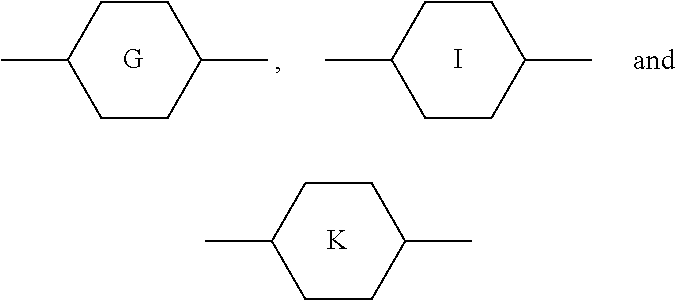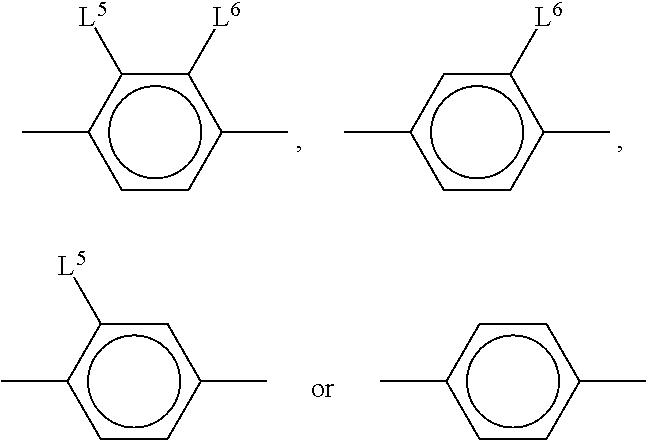Liquid crystal medium
a technology of liquid crystal medium and host mixture, which is applied in the direction of liquid crystal compositions, chemistry apparatuses and processes, etc., can solve the problems of inability to meet the needs of use, etc., to achieve high vhr, low viscosity of the lc host mixture, and high uv absorption
- Summary
- Abstract
- Description
- Claims
- Application Information
AI Technical Summary
Benefits of technology
Problems solved by technology
Method used
Image
Examples
example 1
[0453]The nematic LC host mixture N1 is formulated as follows.
CC-3-V37.00%cl.p.75°C.CC-3-V17.00%Δn0.1098CCY-3-O25.00%Δε−3.2CLY-5-O210.00%ε∥3.5CPY-2-O210.50%K3 / K11.14CPY-3-O210.50%γ187mPa sPY-1-O410.00%V02.34VPY-3-O29.00%PGIY-2-O41.00%
[0454]The mixture contains 1% of a terphenyl compound (PGIY-2-O4).
[0455]Polymerizable mixtures P1-P4 according to the invention are prepared by adding one of the direactive RMs D1 and D2 and one of the trireactive RMs T1 and T2 to the nematic LC host mixture N1. Comparative polymerizable mixture C1 is prepared by adding the direactive RM D1 to nematic LC host mixture C1. Comparative polymerizable mixtures C1 and C2 are prepared by adding the direactive RM D1 or D2 to the nematic LC host mixture N1.
[0456]The RM structures are shown below.
[0457]The compositions of the polymerizable mixtures are shown in Table 1.
TABLE 1Polymerizable Mixture CompositionMix.LCRM D1RM D2RM T1RM T2No.Host[%][%][%][%]C1C10.3000C2N10.4000C3N100.400P1N10.400.050P2N10.3000.1P3N100...
use examples
[0458]The polymerizable mixtures according to the invention and the polymerizable comparison mixtures are each inserted into a VA e / o test cell. The test cells comprise a VA-polyimide alignment layer (JALS-2096-R1) which is rubbed antiparallel. The LC-layer thickness d is approx. 4 μm.
[0459]For polymerization of the RMs each test cell is irradiated with UV light using a wide band pass filter (300 nm<λ<400 nm) at varying radiation energy, and while applying a voltage of 14Vpp (alternating current).
[0460]The tilt angle generated in of various polymerizable mixtures is determined after UV irradiation by a crystal rotation experiment (Autronic-Melchers TBA-105). The tilt angles are shown in Table 2.
TABLE 2Tilt anglesC1C2P1P2C3P3P4UV-Energy / JPretilt Angle / °089.289.289.289.289.289.289.2386.188.687.487.988.687.587.9684.486.186.086.787.686.386.81083.784.384.885.586.586.086.2
[0461]From Table 2 it can be seen that the polymerizable mixtures P1-P4 according to the present invention, which cont...
PUM
| Property | Measurement | Unit |
|---|---|---|
| wavelengths | aaaaa | aaaaa |
| wavelengths | aaaaa | aaaaa |
| tilt angle | aaaaa | aaaaa |
Abstract
Description
Claims
Application Information
 Login to View More
Login to View More - R&D
- Intellectual Property
- Life Sciences
- Materials
- Tech Scout
- Unparalleled Data Quality
- Higher Quality Content
- 60% Fewer Hallucinations
Browse by: Latest US Patents, China's latest patents, Technical Efficacy Thesaurus, Application Domain, Technology Topic, Popular Technical Reports.
© 2025 PatSnap. All rights reserved.Legal|Privacy policy|Modern Slavery Act Transparency Statement|Sitemap|About US| Contact US: help@patsnap.com



